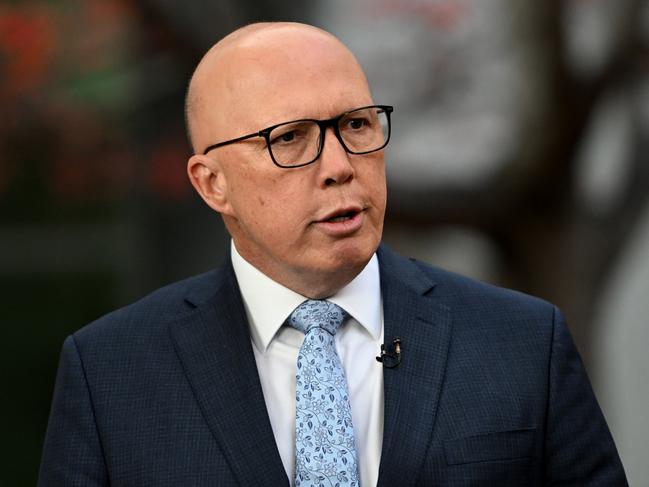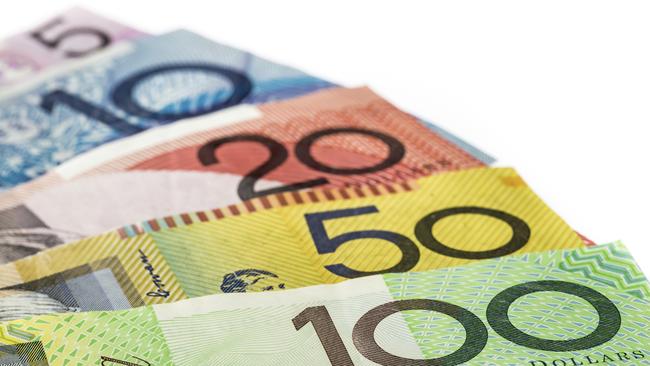PM refuses to rule out early election amid $300 energy rebate backlash
Anthony Albanese has refused to rule out Australian voters could be heading to the polls early, as Peter Dutton slams Jim Chalmers’ energy rebate for the wealthy.
Fed Budget
Don't miss out on the headlines from Fed Budget. Followed categories will be added to My News.
Prime Minister Anthony Albanese has refused to rule out Australian voters could be heading to the polls early after speculation Labor could use its budget to trigger an early election.
It comes amid a backlash against the $300 yearly energy relief rebate announced by Treasurer Jim Chalmers as handed down his third federal budget in Parliament on Tuesday.
Speaking to Sky News Australia, Mr Albanese was asked whether the budget could spark voters to head to the polls sooner than 2025.

“We’re focused on the economy and getting all of the settings right,” Mr Albanese told Sky News host Peter Stefanovic.
“I’ll leave the obsession with politics to the other side. That’s what they did last night. “Initially their gut instinct was to say no to Australian jobs and say no to making things here in Australia.
“They’re addicted to saying no to everything. What we’re focused on is the needs of the Australian economy and the Australian people.”

Opposition Leader Peter Dutton said the Coalition would support the $300 yearly energy relief while questioning why those on high incomes needed the assistance.
“We will (support that) but we need to be honest about it,” he told ABC News Breakfast. “I don’t understand why you and I on high incomes need to get that assistance. Frankly, I think the money would be better provided by way of support to those more in need.”
‘PRECARIOUS’: AUSTRALIA’S DEBT BURDEN
Australia’s debt burden will still comfortably sail past one trillion dollars in the next two years, despite Dr Jim Chalmers talking up his government’s economic credentials on the back of predicted back to back surpluses.
And while Australia’s debt levels remain the envy of other nations, economists are warning that unless the budget undergoes serious structural reform in coming years, it remains in a “precarious” position.
Dr Chalmers, in his budget speech on Tuesday, said the nation’s balance sheet was $215bn stronger over the six years to 2027-28, with reduced debt levels compared with previous forecasts saving “around $80bn in interest costs over the decade’’ ending in 2034-35.
But while the government is forecasting a surplus of $9.3bn this year, following a $22.1bn surplus the previous year, this plunges back to a deficit of $28.3bn in 2024-25, as “pressures on the Budget intensify … rather than ease’’, in the Treasurer’s words.
Dr Chalmers says gross debt this year will top out at $904bn, “instead of the more than one trillion we inherited — meaning debt is $152bn lower’’.
However comparing the detail in the Budget documents to last year’s projections shows the gains on debt over the coming years are minimal.
Gross debt is still expected to grow to more than $1 trillion in 2025-26, reaching a level of $1.007 trillion, just $8bn lower than projected in last year’s Budget.
By the following year the difference is just $3bn, with debt to come in at $1.064 trillion, before increasing by another $48bn the following year.
The Budget documents say that gross debt as a share of the economy is projected to be lower than previously expected “in every year of the forward estimates and medium term, helping to rebuild fiscal buffers to prepare for future challenges’’.
“Gross debt as a share of the economy is expected to peak one year earlier and 0.2 percentage points lower than projected in the Mid Year Economic and Fiscal Outlook (MYEFO),’’ the Budget documents state.
“By 30 June 2034, gross debt is 31.5 per cent of GDP, 0.6 percentage points lower than projected at MYEFO.
“Gross debt is projected to be $183bn lower at 30 June, 2025 … and these improvements save around $80bn in interest costs over the decade.’’
Net interest payments as a share of GDP are expected to increase from 0.5 per cent this year to 0.8 per cent, or $25.9bn, by 2027-28.
The government’s measures of both gross and net debt as a percentage of gross domestic product (GDP) remain low compared with our international peers, with the net debt figure just 20 per cent next financial year, however economists warn that our strong balance sheet owes as much to luck as to sound financial management.
HSBC chief economist Paul Bloxham said in his pre-Budget analysis that while Australia’s public debt levels were low by global standards, “It turns out that much of the reason for strong public accounts is good luck’’.
“The key is that iron ore and other commodity prices are still high, despite China’s substantial property sector correction.
“Good luck indeed. At the same time, the other key generator of national income, Australia’s productivity, has been very weak.’’
Deloitte Access Economics, in its Budget Monitor, says while the net debt position has improved, “the Australian economy is in a precarious position’’.
Deloitte said the government’s fiscal plan relies too heavily on “banking upside revenue surprises”, and “does little to firm the foundations of the long term budget position’’.
“The fiscal position looks increasingly dire the further out one looks,’’ Deloitte Access Economics says.
“With a set of known spending challenges looming on the horizon (and the likelihood of plenty of currently unknown spending challenges, too) the budget needs reform on both the tax and spending side to shore up Australia’s fiscal health for the long term.
“Deloitte Access Economics has not softened its view that Australia needs a major rethink on tax policy.’’
How federal budget is spent
‘inflation could return to target by end of the year’
Australia’s economic growth rate will remain anaemic in coming years, well below our long-term average and lagging the global performance by a long shot.
And, while Treasurer Jim Chalmers says inflation could return to the Reserve Bank of Australia’s desired levels of 2-3 per cent by as soon as the end of this year – bringing with it an increased chance of cuts to official interest rates – this prediction is significantly more optimistic than that offered by the RBA just this month.
While Australia appears to have moved beyond fears that it would slip into a recession – fears that were quite live at this time last year – Treasury’s forecast for economic growth of just 1.75 per cent this financial year, increasing gradually to 2.5 per cent over the next three years, is nothing to celebrate.
This figure is well below Australia’s long-term average of 3.37 per cent over the period from 1960-2023, according to Trading Economics, and will lag the expected global growth rate of 3.25 per cent by a significant margin.
Treasury forecasts also tend to lean towards the optimistic, with the government this time last year predicting the economy would grow at 3.25 per cent in 2022-23, with the actual figure coming in at 3.1 per cent, the budget documents show.
This makes the Treasurer’s prediction for a rapid fall in inflation all the more ambitious.
Dr Chalmers said in his budget speech on Tuesday that “Treasury is now forecasting inflation could return to target earlier, perhaps even by the end of this year’’.
“Annual inflation has more than halved from its peak in 2022 and it’s now lower than anticipated in the mid-year update, but we know people are still under the pump,’’ Dr Chalmers said.
“That’s why we designed our cost-of-living policies to ease these pressures and take another three-quarters of a percentage point off inflation this year, and half a percentage point next year.’’

The budget documents say the cash rate, which is set by the RBA, is expected to “gradually ease” from around the middle of next year to reach 3.6 per cent by the middle of 2026. The official cash rate is currently 4.35 per cent.
Dr Chalmers’ call on the inflation rate hitting the desired band by as soon as the end of this year is distinctly at odds with the RBA’s most recent forecast, which predicts the key measure of inflation, the consumer price index, will remain high at 3.8 per cent at the end of this year, and not return to the 2-3 per cent target range until December next year.
Where federal budget money comes from
AMP chief economist Shane Oliver said this week the near-term risk for interest rates was actually “on the upside”, although his prediction was for a 25-basis point cut in the official cash rate, to 4.1 per cent, in November or December.
Dr Chalmers said the budget was “framed in fraught and fragile global conditions’’, with “the world economy … resilient in parts but subdued overall’’.
“Slower growth means a softer labour market, with unemployment expected to rise slightly to 4.5 per cent next year, even as we create tens of thousands of new jobs,’’ the Treasurer said.
“I want Australians to know that despite everything coming at us, we are among the best-placed economies to manage these uncertainties and maximise our opportunities.
“We have an envied combination of moderating inflation, record new jobs, near-record participation, real wages growth, the lowest-ever gender pay gap, and expanding business investment.’’
The unemployment rate of 3.9 per cent is expected to increase to 4.5 per cent next financial year, where it will remain for three years, the budget documents forecast.
Wages are expected to grow at 4 per cent this financial year, before moderating to 3.25 per cent for the following two years.
On the international trade front, uncertainty is high, with commodity prices expected to drop back to their “long-run fundamental levels’’.
“Australia’s terms of trade, the ratio of export to import prices, are forecast to decline by 15 per cent over the next three years,’’ the budget documents state.
“The outlook for the terms of trade is highly uncertain, reflecting potential volatility in commodity prices.
“Recent developments in the outlook for demand for steel in China and a modest improvement in iron ore and metallurgical coal supply have driven a sharp correction in iron ore and metallurgical coal prices.’’
The budget documents say there are recent indications that steel demand in China has likely peaked, “and a recovery in the supply of iron ore and metallurgical coal has put downward pressure on prices’’.
Originally published as PM refuses to rule out early election amid $300 energy rebate backlash



